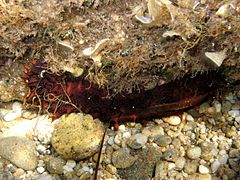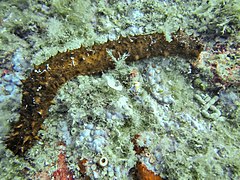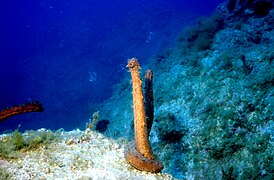Tube sea cucumber
| Tube sea cucumber | ||||||||||||
|---|---|---|---|---|---|---|---|---|---|---|---|---|

Tube sea cucumber ( Holothuria tubulosa ) |
||||||||||||
| Systematics | ||||||||||||
|
||||||||||||
| Scientific name | ||||||||||||
| Holothuria tubulosa | ||||||||||||
| ( Gmelin , 1791) |
The tube sea cucumber ( Holothuria tubulosa ) is a species of the family Holothuriidae that is widespread in the Mediterranean Sea and in the eastern part of the Atlantic Ocean. H. tubulosa was first described by Johann Friedrich Gmelin in 1791 . Synonymous names for the tube sea cucumber are Holothuria cavolinii (Delle Chiaje, 1841), Holothuria columnae (Delle Chiaje, 1823), Holothuria maxima (Delle Chiaje, 1823) and Holothuria pentagnae (Delle Chiaje, 1823).
Appearance and anatomy
The natural body color of the tube sea cucumber is dark brown to purple. Since the epidermis secretes a slimy film on which sediment particles and algae residues can crust, a greyish color is often perceived. H. tubulosa becomes approx. 35 cm long and 8 cm wide. However, length and weight of this type are very variable. The animals grow between summer and autumn. After that, they will lose weight by next summer. Because the species grows quickly within the first year, only rarely smaller individuals have been seen. The average weight of an individual is 220 g. There is no difference in length or size between the sexes. The tube sea cucumber is a segregated species, but does not show any sexual dimorphism. The sexes can only be distinguished macroscopically by the color of the gonads.
The body shell is leathery with embedded ossicles. These small structures under the dermis differ between the sea cucumber species and can therefore be used to identify a species. The body is soft and provided with strong transverse and longitudinal muscles. Like all sea cucumbers, Holothuria tubulosa is secondarily bilateral. The side of the body lying on the ground is called the sole, the upper side is called the bivium. On the sole there are ambulacral feet, which are equipped with suction cups and are used for locomotion. Movement is also possible through the suspensor threads located at the front and rear ends of the body. The ambulacral feet of the bivium are transformed into papillae and no longer have suction cups. The tubular feet in the mouth area are transformed into retractable oral tentacles. There are 20 tentacles around the mouth that have small discs at the end. A disc is surrounded by 5 to 6 divided appendages that serve to feel and grasp the food. The body is supported by the fluid-filled coelom, which serves as a hydroskeleton. Tube sea cucumbers can empty their digestive system through their cesspool. The cloaca is also used for breathing. Fresh water is let in through them and deoxygenated water is expelled. The tissue through which breathing and at the same time the excretion of substances can take place is called the respiratory tree. In addition, you can breathe through the skin. Compared to other echinoderms (Echinodermata), the gonadal structures of the tubular sea cucumber are unpaired.
Distribution area and habitat
Holothuria tubulosa is distributed throughout the Mediterranean Sea and is found in the eastern part of the Atlantic Ocean. It belongs to the species of the Mediterranean with a very high abundance. The tube sea cucumber lives at depths between 5 and 100 m. There it can be found on stony substrate, soft sediment or in seagrass meadows. Small individuals stay in shallow water, whereas larger individuals migrate to deeper zones during the summer period and the resulting rising water temperatures. The population density varies depending on the habitat type and depth. H. tubulosa grows most efficiently in regions with little water turbulence.
nutrition
H. tubulosa is a detritus eater. As sediment eater, they feed on organic particles that are deposited in or on the sediment. These include microorganisms, bacteria, cyanobacteria, mesofauna, microalgae and fragments of marine flowering plants. Their preferred habitat, the seagrass meadow, provides a high proportion of these organic materials. Tube sea cucumbers eat selectively. You can differentiate between nutrient-rich and nutrient-poor particles. The differences in nutrient content are perceived with the help of taste receptors on the tentacles. Which food is preferred depends on the size of the animals. Tube sea cucumbers play a significant role in nutrient recycling. Holothuria tubulosa mixes the top layer of sediment when it eats and reduces the growth of microalgae. The removal of biological contaminants refreshes the water. The contraction of the pharyngeal suspension leads to the opening of the pharynx. This opening simplifies the introduction of the tentacles into the digestive tract. The food accumulates in the pharynx, esophagus and stomach and then pushed into the intestines. The ingested food is moved by contraction waves that pull from the front (anterior) to the back (posterior). The peristalsis is triggered by the circular muscles. Permanent constrictions regulate the amount of food that gets into the intestine. The anterior part of the intestine is almost always free of sediments. At the beginning of the intestine, food is liquid. The food is mixed with digestive fluid to make digestion easier. The sediment is increasingly covered by a layer of mucus from the second half of the intestine. The feces collect at the back of the intestines, rectum and cloaca and are released into pellets.
Reproduction
Tube sea cucumbers are separate sexes. There is an external fertilization. The breeding season of the tube sea cucumber is between June and September. H. tubulosa has an annual reproductive pattern in which six phases of gonadal development can be differentiated. The first phase begins in January. The ovaries or testes begin to develop. In the following phase, the gonads grow until June. From July the gonads are in the third stage and have matured completely. In the fourth phase, the male and female individuals release their gametes. From September the gonads begin to regress (phase 5). In the last period between October and January, the tube sea cucumbers are in a resting phase. At this point they have no detectable gonads. Changes in temperature can lead to changes in the cycle. To bring out the gametes, the tubular sea cucumbers change their typical position, in which the complete ventral side rests on the substrate, into the spawning position. The back third of the body maintains contact with the substrate while the rest of the body is erected. The genital opening is at the oral end and is stretched as far away from the substrate as possible. This position is the most efficient position to achieve maximum spread of the gametes. At this point the body is no longer surrounded by a film of mucus, which means that the dorso-lateral papillae of the back (bivium) are particularly easy to recognize. Males expel a homogeneous white fluid from their genital opening. The substance expelled by the females is yellowish and more impervious to light. The tube sea cucumber needs an average of 20–30 minutes to spread the gametes. The time of gamete release depends on environmental factors. There must be a good flow for the gametes to spread. The water temperature should be between 24 and 26 ° C. In addition, the time of the gamete release depends on the presence of the full moon. Most gamete releases were observed 1 to 2 days after the full moon.
Once the eggs have been fertilized, the larvae hatch within 24 hours. There are several larval stages that can be passed through within a few weeks. By going through a metamorphosis, the larvae become juveniles, which further develop into adult tubular sea cucumbers.
meaning
fishing
Sea cucumbers are an important part of the fishery, mainly consuming the body wall of the sea cucumber known under the names "Trepang", "Beche-de-mer", "Iriko" and "Haisom". They are traditional dishes in China and the Middle East. Products that can be made from H. tubulosa give a high profit in the Asian market. This made the sea cucumber trade very lucrative, with the result that fishing and aquaculture began in other waters as well. Sea cucumbers are fished in more than 70 countries. In the Mediterranean region, tube sea cucumber is caught primarily in Turkey and exported to Asia. On the coasts of Turkey, the tube sea cucumber is picked up by divers and kept alive until it is processed. The processing takes place before the export. The processing steps include cleaning, gutting, cooking, freezing, sun drying and packaging. The tube sea cucumber is more common than other sea cucumbers in the Mediterranean and is also exported more often than other types of sea cucumber. Natural stocks have declined on the Turkish coast. Successful preliminary studies on the production of tubular sea cucumbers in aquaculture in Turkey have already been carried out to counteract the decline.
Red List
Since H. tubulosa is widespread in the Mediterranean and the population is stable, it is classified as not endangered in the IUCN Red List of Endangered Species. In addition, the species has a high abundance in most areas.
Web links
Individual evidence
- ↑ a b Samyn (2013): Holothuria tubulosa , The IUCN Red List of Threatened Species 2013, doi : 10.2305 / IUCN.UK.2013-1.RLTS.T180455A1632895.en .
- ↑ a b c d e Ocana and Sánchez Tocino (2005): Spawning of Holothuria tubulosa (Holothurioidea, Echinodermata) in the Alboran Sea (Mediterranean Sea), Zool. baetica, 16: 147-150.
- ↑ a b Kazanidis et al. (2010): Population dynamics and reproduction of Holothuria tubulosa (Holothuroidea: Echinodermata) in the Aegean Sea, Journal of the Marine Biological Association of the United Kingdom, 90 (5): 895-901.
- ↑ a b Despalatović et al. (2004): Reproductive biology of the holothurian Holothuria tubulosa (Echinodermata) in the Adriatic Sea, Journal of the Marine Biological Association of the United Kingdom, 48 (2): 409-414.
- ↑ a b c d Hickman et al. (2008): Zoology, Pearson Studies, 13: 709-710.
- ↑ a b Féral and Massin (1982): Echinoderm Nutrition: Digestive systems: Holothurioidea. Chapter 9: 191-212.
- ↑ Schmeigger (1820): Handbook of the natural history of the skeletonless, undivided animals, Dyk, Austrian National Library, 540-545.
- ↑ a b Dereli et al. (2016): Reproduction and Population structure of the sea cucumber Holothuria tubulosa in the Dardanelles Strait, Turkey, Mediterranean Marine Science, 17 (1): 44-55.
- ↑ a b Mezali and Soualili (2013): The ability of holothurians to select sediment particles and organic matter, SPC Beche-de-mer Information Bulletin, 33.
- ↑ Isgören-Emiroglu and Günay (2007): The Effect of Sea Cucumber Holothuria tubulosa (G., 1788) on Nutrient and Sediment of Aegean Sea Shores, Pakistan Journal of Biological Sciences, 10 (4): 586-589.
- ↑ Kazanidis et al. (2014): Reproductive cycle of the traditionally exploited sea cucumber Holothuria tubulosa (Holothuroidea: Aspidochirotida) in Pagasitikos Gulf, western Aegean Sea, Greece, Turkish Journal of Zoology, 38: 306-315.
- ↑ FAO (1990): Brief introduction to mariculture of five selected species in China., Sea. cucumber culture, at http://www.fao.org/docrep/field/003/AB736E/AB736E03.htm#ch3.4 .
- ↑ a b Mezali et al. (2014): Reproductive cycle of the sea cucumber Holothuria (Platyperona) sanctori (Holothuroidea: Echinodermata) in the southwestern Mediterranean Sea: interpopulation variability, Invertebrate Reproduction & Development, 58 (3): 179-189.
- ↑ a b Tolon et al. (2016): Effect of stocking density on growth performance of juvenile sea cucumber Holothuria tubulosa (Gmelin, 1788), Aquaculture Research, 1-8.
- ↑ Cakli et al. (2008): Determination of Quality Characteristics of Holothuria tubulosa , (Gmelin, 1788) in Turkish Sea (Aegean Region) Depending on Sun Drying Process Step Used in Turkey, Journal of Aquatic Food Product Technology, 13 (3): 69-78.





